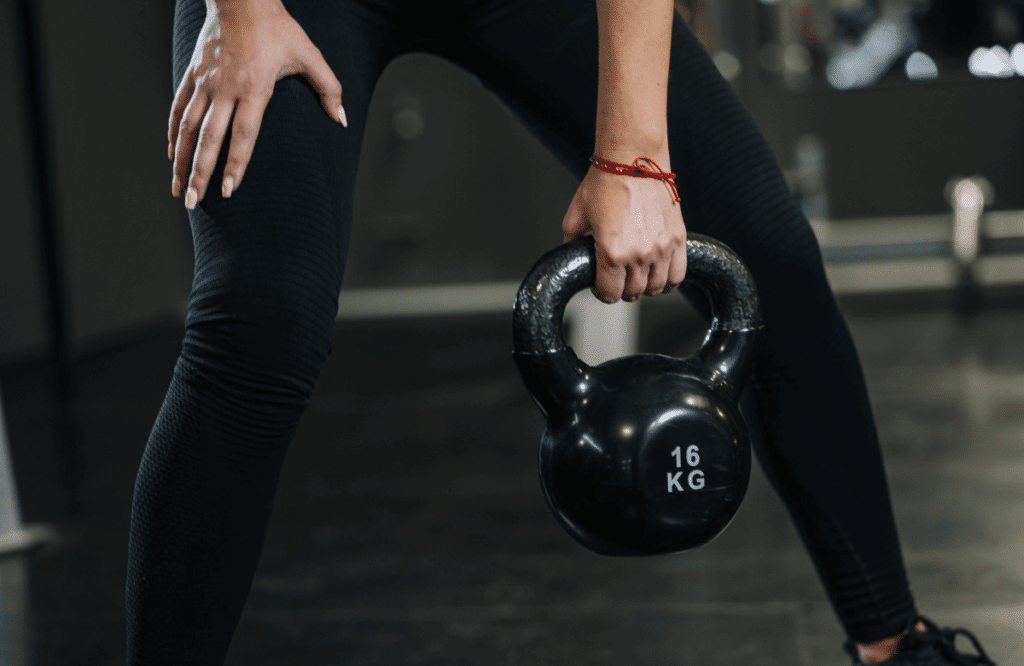Are you interested in trying the kettlebell swing? Are you not sure where to start? Don’t panic. We have you covered.
We go over everything you need to know about the one-arm kettlebell swing in the article below. Read on for more information.
The kettlebell swing is a common starting point for beginners. Many novices and veterans are enticed to try the two-arm swing for its benefits and versatility. But what about the one-arm swing?
The single-arm kettlebell swing is a natural progression from the two-arm kettlebell swing.
The one-arm variation is a much more complex movement, as it requires more stability, grip, and control to execute properly. Beginners should start with the 2-arm swing, as it’s easier to learn and can be loaded heavier.
If you have not perfected the two-handed kettlebell swing, do not move on to the one-arm variation.

Jump to:
How to Do the One-Arm Kettlebell Swing
So, you’ve mastered the two-armed swing, and you’re ready to up the difficulty to the 1-arm variation? You’ve come to the right place.
The 1 arm swing has similar advantages to the traditional two-arm movement but includes anti-rotation elements. The 1-arm variation requires the body to resist rotation via the core muscles, making it a more advanced exercise.
Here’s how you can perform the exercise:
- Take an athletic stance, starting position with your feet shoulder-width apart. Maintain a neutral spine and flat back.
- Keep your neck straight as you swing the kettlebell back with your wrist toward the inner thigh. Do not extend further back than the inner thigh.
- Engage your hips to swing the kettlebell. Avoid using the shoulders to swing the weight.
- Maintain a tight upper back to prevent rounding. Do not twist to overcompensate for the asymmetrical load.
- To lockout the movement, snap your hips forward and tighten the glutes.
- Ensure your arm is straight and swing to chest height.

When to Move Onto the One-Handed Swing
Moving from two-handed KB swings to the one-armed variant can be a big leap. The movement effectively doubles the load on your shoulder and requires more stability, control, and body awareness.
It’s recommended to master the 2-arm swing before moving onto the 1-arm version—but how do you tell if you’re ready?
Stick With the Two-Arm Swing If You Notice These Issues
It’s recommended to continue training with the two-arm swing if you notice the following issues:
- Weak Grip: If you feel like the kettlebell is going to swing out of your hand when performing the single arm kettlebell swing, you need to continue training the two-arm version or improve your grip strength.
- Technique: You need more practice if you can’t keep a front-facing toward with the one-handed swing or you’re experiencing jerky movements.
These symptoms aren’t markers of failure, but they can be signs that you need to improve your strength or technique with the two-arm swing. You may need to increase your workload with the two-arm swing to increase strength or slow down and focus on your form.

How to Progress to the One-Hand Swing
There are a few ways you can progress from the 2-arm swing to the 1-arm swing. You can start by mixing in sets of both variations, focusing on the 2-arm swing. After you build up strength and comfort, you can begin completing full sessions of the single arm kettlebell swing.
Additionally, you can use the following tips to progress to the one-arm swing:
- Practice the two handed swing until you can perform it for 60 seconds at a time.
- When starting, begin with ten reps or 20 seconds on each arm. Repeat three times.
- Practice with lightweight until you can execute the 1-arm swing for one minute on each arm.
- Gradually increase the weight by 5-10 pounds and repeat the first step until you build up to your ideal weight.
Following these tips can help you progress from the two-arm swing to the 1-arm variation while staying injury-free. Ensure you’re not making excessive swings and swing to chest height to avoid injury.
Common Mistakes to Avoid
There are a few beginner mistakes to avoid when performing the one-arm kettlebell swing. Although the movement is similar to the traditional two-hand variation, it can be more complex and difficult to execute. Avoiding these common pitfalls will ensure you’re getting the most bang for your buck and reduce the risk of injury.
Too Much Weight
Using heavy weights that are unmanageable is dangerous for any exercise, including the one-arm kettlebell swing. Too much weight can put excessive strain on your muscles, joints, and ligaments—alongside damaging your form. Always use a comfortable weight that allows you to maintain proper form.
Incorrect Form
Using the incorrect one-handed kettlebell swing form is the quickest path to injury and strain. Because it’s a more complex movement, it’s crucial to perfect the 2-Hand swing beforehand. Mastering the hip hinge and neutral spine positions will help reduce the risk of injury.
Afterward, you must learn how to stabilize your shoulder and prevent the upper back from rounding. Lastly, avoiding twists as the weight swings between the legs is important for efficiency and safety.
Jerky Movements
Although the kettlebell swing is a somewhat explosive and dynamic movement, it’s important to maintain control when executing. Stability is even more important when performing the single arm kettlebell swing, as it’s a more complex exercise. Going slow, using manageable weights, and prioritizing techniques will help you stay injury-free.

Muscles Activated With the One-Arm Kettlebell Swing
A better question might be, “Which muscles don’t the one-arm KB swing activate?“
The kettlebell exercises target several key muscle groups across the entire body. Some of the main muscles are in the posterior chain, alongside the following:
- Hamstring Muscles
- Gluteus Muscles
- Quadriceps Muscles
- Abdominal Muscles
- Core Musculature
- Rectus Abdominis
- Oblique Muscles
- Rhomboid Muscles
- Trapezius Muscles
- Deltoid Muscles
The one-arm KB swing targets primary mover muscles like the quadriceps, glutes, and shoulders. The secondary mover muscles targeted are the traps, rhomboid muscles, and core. Lastly, the muscles in the shoulder, obliques, calves, and spine help stabilize the kettlebell movement.
What Are the Advantages of the Single Arm Swing?
Kettlebell training has several athletic benefits, especially if you’re executing advanced movements like the single arm swing. It’s an excellent exercise that has fantastic muscle activation and program versatility. Here are a few more benefits of the one-handed kettlebell swing:
It’s Comfortable
The one-arm KB swing can be more comfortable than the 2-Arm KB swing, as you’re only using one arm. The kettlebell has more space to move comfortably between the legs without feeling tight or cramped.
Individuals with limited hip mobility can also feel more comfortable with the single arm swing, as they only need to open the legs wide enough to make space for one weight rather than two. The comfortable position of the one-handed kettlebell swing makes it an appealing variation.
Engages the Core
Another advantage to the 1-arm KB swing is that it engages the core muscles more than the standard 2-arm variation. The single arm swing requires more stability to resist rotation, meaning more supporting muscles are needed.
Many lifters struggle with strengthening their core and stability, so the one-arm swing can be a fantastic accessory movement. The benefits to the core strength also reduce the risk of injury and improve daily functioning.
Improves Grip Strength
Another advantage of the kettlebell swing is that it can enhance grip strength. The one-handed swing is a powerful exercise that requires explosive movements with a single hand.
Practicing the one-handed kettlebell swing can cause significant improvements to grip strength when performed correctly. The movement is a great choice if you’re looking to improve grip strength for sport, fitness, climbing, or even deadlifts.
Frequently Asked Questions (FAQ)
Is the One Arm Kettlebell Swing Good?
The one-arm KB swing is a safe and effective movement when performed correctly. It targets several muscle groups like the glutes, hamstrings, shoulders, core, and more. As a compound movement, it burns more calories and can improve functional strength in daily activities. Just be sure to avoid exaggerated swings and poor form.
Why Is the Kettlebell Swing So Effective?
The kettlebell swing is effective, as it’s an easy way to increase heart rate, burn calories, and build strength. It’s a versatile movement that can be included in CrossFit, body-building, and boot-camp-style programs. It also acts as a compound movement that targets several muscle groups.















